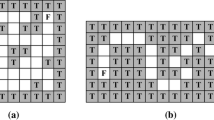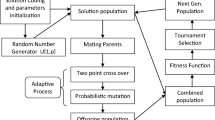Abstract
The XCS classifier system is a rule-based evolutionary machine learning system. XCS evolves classifiers in order to learn generalized solutions. The XCS with adaptive action mapping (XCSAM) is inherited from XCS, which evolves a best action map where it evolves classifiers that advocate the best action in every state. Accordingly, XCSAM can potentially evolve solutions that are more compact than XCS, which in contrast focuses on a complete action map. Previous experimental results however have shown that, in some problems, XCSAM may produce solutions with more classifiers than XCS. In this paper, we initially show that the original fitness-based selection strategy of XCS produces non effective classifiers which are not likely to be in the best action map (i.e., they are inaccurate ones or do not have best actions) in XCSAM. Then, we introduce a new selection strategy for XCSAM that promotes the evolution of classifiers advocating the best action map and thus produces more compact solutions. The new strategy selects classifiers based both on their fitness (like XCS) and on the parameter optimality of action of XCSAM. The result is a pressure towards classifiers that are accurate and advocate the best actions. We present analyses showing that the new selection strategy successfully enables XCSAM to focus on classifiers having best actions. Our experimental results show that XCSAM with the new selection strategy (called XCSAM-SS) can evolve smaller solutions than XCS (and the original XCSAM) both in single-step and multi-step problems. As a consequence, XCSAM can also learn with smaller iterations than XCS in the single-step problem. Our conclusion is that, as the best action map potentially has a compact solution, XCSAM evolves a much compact solution than XCS by adding an adequate selection strategy.












Similar content being viewed by others
Explore related subjects
Discover the latest articles, news and stories from top researchers in related subjects.Notes
XCSAM uses the selection array for single-step problems because in these problems it sometimes overestimates the system prediction for the not-best actions. This happens because it is easy for XCSAM to find a pure best action map when there are only two possible rewards. But sometimes mutation changes the action of a classifier from best to not-best action and the offspring temporarily inherits the high prediction of the parent. This has been observed in single-step problems but not in multi-step problems. We hypothesis this problem does not occur in multi-step problems because XCSAM does not find a pure best action map [25] but finds an adaptive action map where some not-best actions remain to keep generalized classifiers; and the not-best actions in it prevent occasional mutations from changing the max system prediction.
References
Bernadó-mansilla E, Garrell-Guiu JM (2003) Accuracy-based learning classifier systems: models, analysis and applications to classification tasks. Evol Comput 11(3):209–238
Bull L, Bernadó-Mansilla E, Holmes JH (eds) (2008) Learning classifier systems in data mining, volume 125 of Studies in computational intelligence. Springer, Berlin
Bull L, Lanzi PL (2009) Introduction to the special issue on learning classifier systems. Nat Comput 8(1):1–2
Butz MV, Kovacs T, Lanzi PL, Wilson SW (2004) Toward a theory of generalization and learning in XCS. IEEE Trans Evol Comput 8(1):28–46
Butz MV (2006) Rule-based evolutionary online learning systems. Springer, Berlin
Butz MV, Goldberg DE, Lanzi PL (2005) Gradient descent methods in learning classifier systems: improving XCS performance in multistep problems. IEEE Trans Evol Comput 9(5):452–473
Butz MV, Goldberg DE, Tharakunnel K (2003) Analysis and improvement of fitness exploitation in XCS: bounding models, tournament selection, and bilateral accuracy. Evol Comput 11(3):239–277
Butz MV, Lanzi PL, Wilson SW (2008) Function approximation with XCS: hyperellipsoidal conditions, recursive least squares, and compaction. IEEE Trans Evol Comput 12(3):355–376
Butz MV, Wilson SW (2002) An algorithmic description of XCS. Soft Comput 6(3–4):144–153
Dixon PW, Corne DW, Oates MJ (2004) Encouraging compact rulesets from XCS for enhanced data mining. In: Bull L (ed) Applications of learning classifier systems, studies in fuzziness and soft computing, vol 150. Springer, Berlin, pp 92–109
Dixon PW, Corne D, Oates MJ (2002) A preliminary investigation of modified XCS as a generic data mining tool. In: Lanzi PL, Stolzmann W, Wilson SW (eds) Revised papers from the 4th international workshop on advances in learning classifier systems, IWLCS ’01, Springer, London, UK
Dixon PW, Corne DW, Oates MJ (2003) A ruleset reduction algorithm for the XCS learning classifier system. In: Learning classifier systems. Springer, Berlin, pp 20–29
Ebadi T, Zhang M, Browne W (2012) XCS-based versus UCS-based feature pattern classification system. In: Proceedings of the fourteenth international conference on genetic and evolutionary computation conference, ACM, pp 839–846
Goldberg DE (1989) Genetic algorithms in search, pptimization, and machine learning. Addison Wesley, Reading
Katagami D, Yamada S (2000) Interactive classifier system for real robot learning. In: Proceedings of 9th IEEE international workshop on robot and human interactive communication, 2000. RO-MAN 2000. IEEE, pp 258–263
Kharbat F, Bull L, Odeh M (2007) Mining breast cancer data with XCS. In: Proceedings of the genetic and evolutionary computation conference (GECCO2007), pp 2066–2073
Kovacs T (1996) Evolving optimal populations with XCS classifier systems. Technical report CSR-96-17 and CSRP-96-17, School of Computer Science, University of Birmingham, Birmingham, UK
Kovacs T (2000) Strength or accuracy? Fitness calculation in learning classifier systems. In: Lanzi PL, Stolzmann W, Wilson SW (eds) Learning classifier systems, volume 1813 of Lecture Notes in Computer Science. Springer, Berlin, pp 143–160
Lanzi PL (1999) An analysis of generalization in the XCS classifier system. Evol Comput 7(2):125–149
Loiacono D, Orriols-Puig A, Urbanowicz R (2012) Special issue on advances in learning classifier systems. Evol Intel 5(2):57–58
Nakata M, Kovacs T, Takadama K (2014) A modified XCS classifier system for sequence labeling. In: Proceedings of the 2014 conference on genetic and evolutionary computation, GECCO 2014. ACM, pp 565–572
Nakata M, Lanzi PL, Takadama K (2012) Enhancing learning capabilities by XCS with best action mapping. Parallel problem solving from nature (PPSN XII), pp 256–265
Nakata M, Lanzi PL, Takadama K (2012) XCS with adaptive action mapping. The ninth international conference on simulated evolution and learning (SEAL 2012), pp 256–265
Nakata M, Lanzi PL, Takadama K (2013) Selection strategy for XCS with adaptive action mapping. In: Proceedings of the 15th annual conference on genetic and evolutionary computation, GECCO ’13, New York, NY, USA. ACM, pp 1085–1092
Nakata M, Lanzi PL, Takadama K (2014) Evolving best action maps in accuracy-based reinforcement learning classifier system. Evol Comput (submitted)
Orriols-Puig A, Bernadó-Mansilla E (2005) Class imbalance problem in UCS classifier system: fitness adaptation. In: CEC2005, vol 1, pp 604–611. IEEE
Orriols-Puig A, Bernadó-Mansilla E (2009) Evolutionary rule-based systems for imbalanced data sets. Soft Comput 13(3):213–225
Shafi K, Abbass HA, Zhu Weiping (2007) Real time signature extraction from a supervised classifier system. In: IEEE congress on evolutionary Computation. CEC 2007, pp 2509–2516
Shafi K, Urbanowicz R, Iqbal M (2013) Special issue on advances in learning classifier systems. Evol Intel 6(2):55–56
Sutton RS, Barto AG (1998) Reinforcement learning—an introduction. MIT Press, Cambridge
Wilson SW (1995) Classifier fitness based on accuracy. Evol Comput 3(2):149–175
Wilson SW (2002) Compact rulesets from XCSI. In: Lanzi PL, Stolzmann W, Wilson SW (eds) Advances in learning classifier systems. Springer, Berlin, pp 197–208
Zang Z, Li D, Wang J (2013) Knowledge extraction and rule set compaction in XCS for non-Markov multi-step problems. Evol Intel 6(1):41–53
Acknowledgments
This work was supported by the JSPS Institutional Program.
Author information
Authors and Affiliations
Corresponding author
Rights and permissions
About this article
Cite this article
Nakata, M., Lanzi, P.L. & Takadama, K. Rule reduction by selection strategy in XCS with adaptive action map. Evol. Intel. 8, 71–87 (2015). https://doi.org/10.1007/s12065-015-0130-1
Received:
Revised:
Accepted:
Published:
Issue Date:
DOI: https://doi.org/10.1007/s12065-015-0130-1




